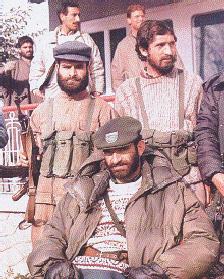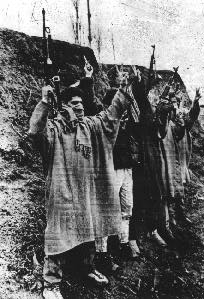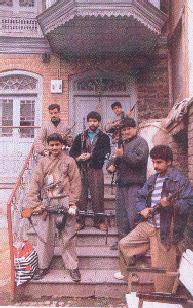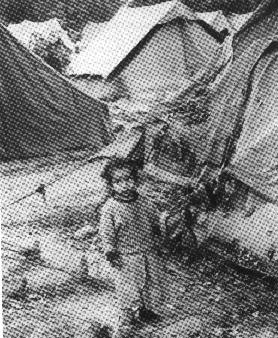Islamic Fundamentalism in Kashmir
Ethnic Cleansing of Kashmiri Pandits
The Muslim and Hindu peoples of Kashmir have lived in relative harmony and friendliness since the 13th century when Islam first became the majority religion in Kashmir. The Sufi-Islamic way of life that ordinary Muslims followed in Kashmir complemented the rishi tradition of Kashmiri Pandits (Hindus), leading to a syncretic culture where Hindus and Muslims revered the same local saints and prayed at the same shrines.Â
 The masked terrorists in Kashmir: Pawns in a bigger game.
The masked terrorists in Kashmir: Pawns in a bigger game.Periodically however, there have been rulers and leaders who have had a narrow view of Islam, and have subjected Hindu minorities to great cruelties and discrimination. The current armed secessionist movement in Kashmir mostly derives its inspiration from these people.Â
 Terrorist leader with bodyguards.
Terrorist leader with bodyguards.A canard is now being spread past few years by the secessionist-terrorists and their sympathizers that in 1990 Kashmiri Pandits left Kashmir willingly, having been "tricked" by then Jammu and Kashmir Governor Jagmohan. Nothing could be farther from the truth. The fact is that Kashmiri Pandits were driven from their homeland after a campaign of intimidation and harassment was launched against them by the military-wing of the secessionists. Kashmiri Pandits were forced from their hearths and homes at the point of gun. The objective of this ethnic cleansing was to create a minority-free Kashmir valley where the goal of Islamization could be easily forced on the ordinary people. The books and articles below will provide you with an in-depth understanding of the genesis of the current political situation in Jammu and Kashmir.
This website aims to tell the story of Kashmir as it was and what has become of it now. Contrary to the misinformation currently being propagated, India did not "annex" Kashmir. At the time of independence in 1947 from British rule and the subsequent partition of the country into theocratic Pakistan and secular India, the Hindu Maharaja of Jammu and Kashmir had the option to join India, Pakistan, or remain independent. He contemplated the latter option, but after Pakistan invaded Kashmir hoping to preempt such a decision, he decided to accede to India. This accession was ratified by Sheikh Mohammed Abdullah, head of the largest political party (the National Conference) representing the Muslim majority of the state. The Sheikh did so because he felt that the interests of Kashmiri Muslims, who practice the secular Sufi-Islamic way of life, would be best served under the protection of the Indian constitution.


The present secessionist drive in Kashmir has its antecedents in the dissatisfaction of a small and insignificant section of Kashmiris (mostly political opponents of the Sheikh). However, since about 1985, this drive has been hijacked by Islamic fundamentalists who have resorted to terrorist tactics, targeting Hindus, Sikhs, and secular Muslims. Since 1990, with training and support from Pakistan, the terrorists are engaged in a low- intensity war against India for establishment of a theocratic nation in Jammu and Kashmir.
To further their cause the secessionists have completed a program of ethnic cleansing, expelling about 350,000 Kashmiri (Pandits) Hindus - something that has unfortunately gone largely unreported in the Western press. These Pandits are at present living as refugees in their own country.
 The refugee camps at Jammu.
The refugee camps at Jammu.
The following pages will show you a glimpse of the history, culture, and the current plight of Kashmiri Pandits. You will understand the goals of the bigoted religious terrorists in Kashmir whose vision of Azadi (independence) is to use religious dogma to exclude women, religious minorities, and secular-minded people from every kind of freedom in social and political life.
Fourth International Symposium on Terrorism in Kashmir, May 8, 1993
Knowing that these are the facts, then how come these are not well publicized in the West? Is it that West does not have the means to discover the facts or they simply do not have the Interest? Surely it can not be the lack of resources.
A Valley in Tears
As the tragedy in Kashmir unfolds, human rights organizations in India and a road continue to censure India for its violations of the rights of terrorists to kill, maim and intimidate those who would differ with them.
Kashmiris demand a Homeland
The year is 1492. King Ferdinand of Spain has given the Jews of Spain a choice - either convert to christianity or leave the country. Some 200,000 Jews flee for their lives.
Kashmir: Garden of the Sages
According to Pandit Kalhan\'s Rajatarangini, the present Valley of Kashmir used to be an enormous lake called Satisar. The great sage Kashyapa prayed for a long time to Maheshwara to provide him dry land out of this lake.
Kashmiri Migrants\' Health Trauma - a Study by Dr. P. K. Hak
One facet of the multidimensional human rights violation against the Kashmiri Hindus is the health trauma-physical, mental and psychological, resulting from the forced exodus of the community.
Psychological and Behavioural Problems of Kashmiri Migrants by G. K. Muju
The displacement of about two and a half lakh Kashmiri Hindus from the peaceful Valley has caused a number of psychological and behavioural problems.
Of Terrorists and Tormentors
Nearly three years after the Kashmiri Pandit Community was subjected to brutal killings, wholesale devastation and the unparalleled mass paralyzing terror and booted out of the Valley
Role of Human Rights Organisations
Human Rights and Human Survival are inalienably linked. In concrete terms, the endurance of the society is a human right.
Question of Kashmir
The most striking example of our failure is the continuing problem of Kashmir which has been draining our resources ever since 1947, particularly during the past six years since militancy has gained ground in J&K.
Pre-1953 Kashmir Not Feasible
Will a return to the pre-1953 situation in Kashmir redress the grievances of the Kashmiris and recognise their right to shape their political and economic future?



